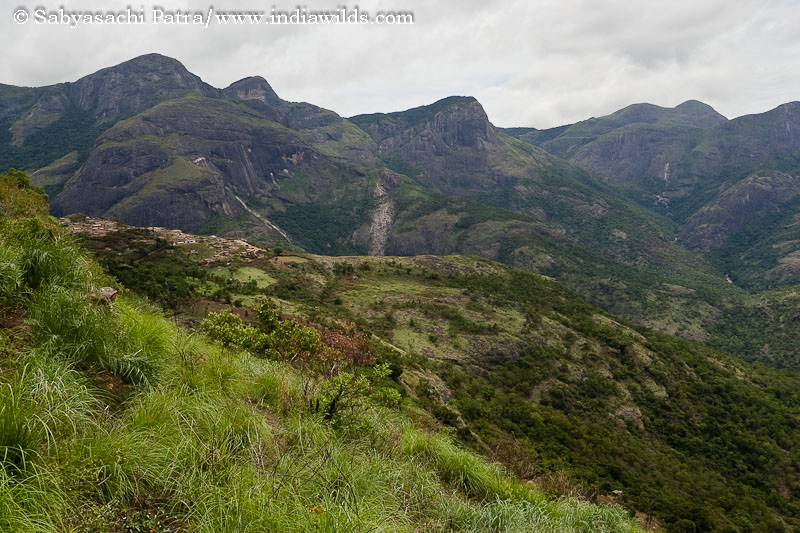IndiaWilds Newsletter Vol. 9 Issue VIII
Conservation: Tree Plantation & Economics

Indiawilds Newsletter Cover Page -August 2017
India with a population of 130 crores (1.3 billion) is bursting at its seams. Our once predominantly agricultural and self-sustained economy has been torn asunder by the faulty planning system which only puts emphasis on industrial growth and services at the cost of agriculture. India’s efforts to ape the development model of the west have brought in lot of challenges and India’s nature, environment and wildlife has borne the brunt of it.
Too often it is said that conservation is not succeeding because it is seen as anti-development. Politicians unabashedly say that in the battle of Conservation vs Development, it is the later which should win. Of course it is another matter that every thing looks rosy because of the way development is defined in very narrow terms.
It is also said that nature conservation has failed because it doesn’t have the support of people. Too often, we engage in tree plantation and then after sometime the trees are uprooted or cutoff to make way for concrete buildings as people think they will get better returns by constructing buildings rather than keeping the land with trees. All of us know that trees are beneficial to all of us in the long run. Any child can tell us that the trees absorb the carbon dioxide from the air and give back oxygen. Trees also stop the topsoil from being washed away and help in percolation of water so that the groundwater is recharged. However, we often forget that even in narrow tangible economic terms, as defined by hard-nosed accountants, trees are profitable for people.

Shola Forests
Recently I was talking with a gentleman from a small town in Uttar Pradesh. He told me that some 20 years ago he and his brothers had planted trees in their land. Now the trees have become very valuable. The cost of wood has gone up tremendously. In his area seesham is sold at upto 2000 rupees per cubic feet. Due to lack of wood people are even using mango wood, which has got lot of moisture content and gives difficulty during seasoning. These days trees as young as 15 years are also cut off. Log of a 50 year old tree is difficult to find as people are greedy and cut off the trees much before time. The gentleman told me that he didn’t cut off his trees but is allowing them to grow as his trees will fetch more money later. So he is even buying wood for use in his own house now. He even reeled off local prices of different types of wood to bolster his point.
I tried to be devils advocate and asked him where to plant trees, as people try to construct residential houses or commercial shops in their land and earn money. He responded by telling me that it is important to leave space for trees while constructing your house. In his earthy language he explained, what many finance professionals know, that house is a depreciating asset whereas tree is an appreciating asset.
Every year you spend money in house maintenance. However, you just need to give water to a tree in the initial days and then largely the trees grow on their own by spreading their roots deep and wide and getting the nutrients and water even though we don’t give those to the tree. Each tree after a few years is worth several lakhs. If you plant five or six trees when your child is born, then you have no tension when the kid is grown up as trees can offset the money requirement after twenty years.
He then proceeded to show me the commercial buildings that he is constructing in his land and how he has left 15 feet by 25feet space in front facing the road. He said that he is going to plant trees there. The trees will act as a barrier to the dust from the road. And when his son grows up, he will find that the trees would have grown tall and wide and that would be his legacy for his kid. These words coming in chaste hindi from an ex-LIC agent may be easily dismissed by people these days. However, language is not often the true barometer of knowledge. We have heard of people building houses, temples and leaving behind lot of wealth as their legacy for their kids. However, we don’t often hear that someone is leaving behind trees as wealth and legacy for their kids.
There was a time in ancient India, when trees were worshipped as Vriksha devata (also pronounced as Bruksha devata). People knew the benefit of trees. These days since we buy everything from the mall, we don’t care if the tree gives us fruit, flower, wood, edible roots or oxygen. At the moment oxygen is only bought for the sick or for high altitude mountain climbing, however, the way we are destroying the environment, the day is not far off when we will be actively buying oxygen cylinders from the malls.

Pollution due to transport mess
These days people have been very narrow in their outlook as the quest for money trumps everything else. In India, we know that the middle class hardly votes but makes its views disproportionately loud in TV channels, social media, coffee shops etc. However, we know that in elections it is the masses (often derogatively called as the unwashed masses) decide the fate in the elections. After India got its independence it is these teeming millions of people who decided that Independence from British rule means they can destroy our natural heritage at their own sweet will without any thought about its consequences. So our natural heritage was plundered and soon hills were denuded and forests become barren and rivers started running dry. It is the same people who had created a big impact by hugging trees and stopping cutting down of the trees in the “Chipko movement” in 1973. So now when the thought of planting trees is coming from people from smaller towns and not from the so-called elites, I feel there may be some hope for nature and environment.

Chipko Movement Image Courtesy – online media
Can the Government play a role?
In India there was a time when there were less number of houses and hence tax breaks were provided for housing. It may be a good idea to replicate that with respect to tree plantations.
Tax breaks for Tree Plantation:
India has long argued in international climate change negotiations including the COP at Paris that high carbon lifestyles of the rich has led to the present state of the environment. So the rich countries have to help the developing countries in climate change mitigation. If we use the same logic, we the people staying in urban India in big cities don’t even have a square inch of land in our expensive apartments. So we are the greedy consumers of oxygen. The people in smaller towns as well as in rural India still have land for trees. Let the Government give the people tax benefits for their trees. People are known to do anything to get the tax benefits. So let the tax benefits force people to plant more trees.
This may sound like a simple concept but difficult to implement. The mandarins in the North Block manning the finance ministry will think that there is enough scope for leakages. However, there is also technology to make it fool proof. Let people click images of trees and periodically upload with the GPS coordinates. With this the existence of trees and their growth can be verified periodically. Let the trees data be open for public, so that those can be verified by others as well as whistle blowers.
This will also economically help the hilly areas of our country, which are at present languishing due to lack of industries. Most of the North East states, which are virtually acting like the lungs of India due to the greenery in those places, can be beneficiaries. This will help the North East as well as hilly states like Uttarakhand and Himachal Pradesh, retain and maintain their forests. Hopefully, many youth can find jobs due to this and it will reduce the flow of the youth seeking small jobs in big cities.
Green Areas with Tall Native Trees:
The Government can also play a role by mandating that the green areas in SEZs, industries, residential complexes comprise of trees and not just lawns. Industries as well as housing societies try to make the green area as playgrounds. The lawns with Korean grass doesn’t benefit us ecologically. Infact, the lawns suck away more water. So the Government has to force these big industries and residential complexes to mandatorily plant native trees which can grow into tall and big hard growth trees. The potential of carbon sequestration of native large trees is way more than the ornamental plants and lawns that we often find in these places.

Native Curry Leaves plant
When tall trees are planted outside the buildings, they also result in bringing down the temperature and in the long run this would be beneficial to the industries in reducing their AC cooling costs. Trees also act as barrier and catch the suspended particulate matter from the air. This helps in improving the quality of the air that people breathe in.
Our urban areas are heavily concretised. People build on every square inch of land that they have as they feel constructing rooms will result in they getting rental income. If people as well as housing societies and industries start leaving land without concretising it and planting trees, then it will also result in lowering the impact of hot summers. These days, the urban areas are getting very hot because the layer of air surrounding the buildings and cities heat up and create a “heat island” effect. Planting more trees around the buildings will help in lowering the temperatures.
Though it would be a very good idea to encourage people to plant trees, it would be pertinent to mention that one can plant trees but forests have their own place. Planting trees in vacant plots, gardens or large industrial areas can’t replace our fast vanishing forests. Social forestry has its place. It reduces the dependency of the people on the forests. And if conducted on a large scale in fallow lands, revenue lands and other large unused lands and if these social forestry projects are left without much disturbance then they can become the home to many wild species. However, there is no replacement for forests. We must protect our forests and make them inviolate so that not only our wildlife can live in peace but also the rivers and streams that originate from these places continue to remain alive.
India’s teeming millions who have access to land can benefit from this. So what would be the role of urban elite in this? Perhaps forward this article without implementing, like the many jokes we forward by email and whatsapp, and later marvel at the small town guy who actually implements it and makes money as well as remains healthy.
Conservation News:
Air Pollution causing DNA defect in Kids & Teens:
Kids and teens who are regularly exposed to air pollution due to high traffic on the roads are likely to face telomere shortening which is a form of damage to their DNA. This was found in a study conducted in Fresno in California, USA. California is the second most polluted city in the US (Traffic-Related Air Pollution and Telomere Length in Children and Adolescents Living in Fresno, CA: A Pilot Study; Lee EY et al., Journal of Journal of Occupational and Environmental Medicine, May 2017 ).

Pollution
The researchers studied the relationship between polycyclic aromatic hydrocarbons (PAHs) which are found in the vehicle exhausts and the telomere shortening. It was found that the intensity of vehicle exhaust is directly correlated to decrease in telomere length.
Subjects with and without asthma were selected based on their annual average PAH level in the 12-months prior to their blood draw. The researchers measured the relative telomere length from peripheral blood mononuclear cells (PBMC).
The researchers found an inverse linear relationship between average PAH (Polycyclic Aromatic Hydrocarbon) level and Telomere length TL (R = 0.69), as well as between age and TL (R = 0.21). Asthmatics had shorter mean telomere length than non-asthmatics (TLasthmatic = 1.13, TLnon-asthmatic = 1.29).
These study findings is alarming as it shows the impact of traffic pollution in the molecular level and it also correlates with the empirical observations of higher incidences of kids falling victims to pollution in our cities. It would be important to conduct similar studies in India with bigger sample size. Wish the Union Health ministry can look into this serious issue and then work in tandem with the environment ministry, transport ministry as well as industries and urban development ministries to bring the pollution under control in our big cities.
India all set to access resources under the Green Climate Fund for Finance Climate Action
Indian Government has signed Accreditation Master Agreement (AMA) between Green Climate Fund (GCF) and National Bank for Agriculture and Rural Development (NABARD).
India has nominated a total of five direct access entities for accreditation by the GCF. Two of these from the public sector and three from the private sector for accreditation by the GCF. The public sector entities are NABARD and Small Industries Development Bank of India (SIDBI). The private sector entities nominated are YES Bank, IDFC Bank and IL&FS Environmental Services. So far, NABARD and SIDBI have been accredited by the GCF. The accredited entities need to proactively engage with GCF to take advantage of the available opportunities.
NABARD is the first entity from India to be accredited as Direct Access Entity (DAE). The signing of AMA between GCF and NABARD is an essential first step for accessing the GCF resources to help safeguard the lives, property and livelihoods of millions of people against climate change impact.
The Green Climate Fund (GCF) is one of the operating entities under financial mechanism set up under the United Nations Framework Convention on Climate Change (UNFCCC) to provide support to developing countries in combating climate change, with resources to be generated from funding by developed country Parties and various other public and private sources. It supports both climate change adaptation and mitigation projects in developing countries.
The Green Climate Fund (GCF) has identified 8 impact areas which will deliver major mitigation and adaptation benefits such as:
Shifting to low-emission sustainable development pathways through:
1 Low-emission energy access and power generation
2 Low-emission transport
3 Energy efficient buildings, cities and industries
4 Sustainable land use and forest management
Increasing climate-resilient sustainable development for:
1 Enhanced livelihoods of the most vulnerable people, communities, and regions
2 Increased health and well-being, and food and water security
3 Resilient infrastructure and built environment to climate change threats
4 Resilient ecosystems
So far, one project from India on “Installation of Ground Water Recharge System” in Odisha has recently been approved by the GCF for $34 million. Another proposal on coastal areas has already been submitted to the GCF Secretariat and several more projects are in the pipeline.
India’s Union Minister of Environment, Forest and Climate Change, Dr. Harsh Vardhan while speaking on the occasion of the signing of Accreditation Master Agreement (AMA) between Green Climate Fund (GCF) and National Bank for Agriculture and Rural Development (NABARD) said “India, like other developing countries, can do more, if finance and technology development & transfer and capacity building support are ensured as per the convention and its Paris Agreement”. The Minister also claimed that India has been leading from the front in tackling global climate change issues and it will continue to do so in the future as well. The Minister however emphasised that climate justice demands that we remain mindful of the needs and aspirations of the poor. India despite being one of the fastest growing economies of the world, has a significant percentage of population living below the poverty line. “We need to take cognizance of the population size and income inequality and cannot ignore the basic requirement of electricity, housing and food for the poor. We expect GCF to partner with us on these issues and prioritize their work to overcome these challenges”.
African Cheetah reintroduction reboot:
The Central Government has once again rebooted the project for alien African Cheetah reintroduction in India. The Government through its arm NTCA (National Tiger Conservation Authority) has moved an application in the Hon’ble Supreme Court for clarifying the 2013 Supreme Court order.
The Government has said that Cheetah is not an alien animal and is mixing the facts that the African and Asiatic Cheetah’s are different. It is relying on “expert opinion” of experts who were earlier involved in the relocation project to say that the genetic variation between the Asiatic and African Cheetah is not much. It may be pertinent to say that the genetic difference between the humans and Chimps are also not much ie. only 0.1%.
The Government had planned to introduce Cheetah’s in Kuno-palpur in Madhya Pradesh which was quashed by the Hon’ble Supreme Court. Incidentally, the Supreme Court had asked for introduction of Lions in Kuno-Palpur which Gujarat has been resisting. The current Prime Minister had resisted the relocation of lions from Gujarat when he was the Chief Minister of Gujarat. After becoming Prime Minister Mr. Modi hasn’t officially said a word against the relocation. Nevertheless, the lion relocation project is not taking off despite Madhya Pradesh Government having spent considerable amount of money in creating the habitat and relocating the villages because Gujarat is not ready to implement the Supreme Court Order. Now, the move to reintroduce Cheetah in Kuno-Palpur is seen by some to further obfuscate the issue of lion relocation.
One single stroke of bad luck in form of disease can wipe out the lions in Gujarat. History may not take a benevolent view of subverting conservation moves for political gains. However, who cares for History?
NBWL tears away 1000 hectares from Palamau :
National Board for Wildlife (NBWL) the premier clearing house for wildlife projects has again stamped its approval on the destruction of another Tiger Reserve, this time it is Palamau in Jharkhand. 1000 hectares of Palamau Tiger Reserve has been approved for diversion to complete the building of the Kutku Mandal dam of the North Koel Irrigation Project. The NBWL was well aware that because of this project “the tiger may lose substantial resource rich habitat”. NBWL says “The core area should be expanded suitably to cover adjoining uninhabited buffer zone or other forest areas to strengthen conservation measures, as proposed by the state wildlife board in its site-specific wildlife management plan for mitigation of impacts due to Mandal dam.” They propose to add the adjoining area to the tiger reserve which are basically barren wastelands which will need a lot of time to develop as a tiger habitat.
This diversion will involve 3,44,644 trees. Though on paper they say that similar number of trees will be planted elsewhere, the NBWL perhaps fails to understand that you can plant trees but you can create a forest. Each tree has got its own microhabitat for various species. The interrelationship between different trees, shrubs, bushes, climbers along with various species of insects, herpetofauna, birds and mammals are tough to recreate. Modern science hasn’t understood the complex relationships. So it is basically putting a death knell on the habitat and its inhabitants. This will lead to the large mammals moving out the forest and trying to find a way to other suitable habitat and or try to eke out a living in a substandard habitat and hence there will be more man-animal conflicts due to this project. No body has estimated how much would be the impact of man-animal conflict.
It may be pertinent to mention that this project was stalled due to protests by tribals in 1997. Now it is revived because money had been spent on it earlier. The previous UPA Government and the present Modi Government have the same policy of completing environmentally disastrous projects because money had been spent on the project before taking environment clearance. In the present case, the project was stalled before the present forest rights act came into existence.
Palamau was one of the first tiger reserves. It had a very rich habitat. However lack of protection, impact of naxalites and greed of people resulted in the tiger reserve suffering the heaviest among all the tiger reserves in the country. With this move of NBWL tearing away prime tiger habitat, it is tough times for Palamau. Like everywhere else in India, it is a very bad time for the Tiger and other Wildlife.
SC asks to explain Mining at Dibru-Saikhowa:
The Hon’ble Supreme Court has asked the Solicitor General to produce an affidavit regarding the reasons for Standing Committee of the NBWL approving mining in Dibru-Saikhowa National Park. The Supreme Court also wants to know about the conditions mentioned, the various safety measures that are prescribed as conditions, the mitigation measures to be taken by both the Forest department as well as Oil India so that the no damage to the forests and environment happen in the vicinity of the park.
Indian Oil is drilling only oil wells 1.5kms away from the National Park. It proposes to use HDDDT (Horizontal Deviation Directional Drilling Technology) and ERDT (Extended Reach Drilling Technology) to drill below the National Park. The horizontal pipes employed by it will go below the National Park. The Environment Ministry has gone back on its decision and has said that drilling for Oil and Gas is not mining and hence is not covered by the Supreme Court order which restrains mining within 10kms of the National Park. Since there is not enough evidence about the kind of impact these technologies can bring upon, it may be difficult to argue against it. In earlier days the rule of thumb principle was “when in doubt, leave it out”. These days however, the quest for GDP has resulted in throwing caution to the winds. Supreme Court will again hear this issue on 7th of September.
‘Gaja Yatra’ to mark World Elephant Day 2017
The MoEF&CC has launched “Gaja Yatra” a nationwide campaign to protect elephants. This was launched on 12th August on the Occasion of World Elephant Day. This campaign is planned to cover 12 elephant range states. During the period of the campaign, artists and craftsmen will create life-size works on the theme of elephants in places along the route of the roadshow, covering 12 states that have wild elephants, using local art and craft. Specially fabricated vehicles will be deployed to display these on pre-determined routes with campaigners. The ‘Gaju’ mascot, which was released by the Ministry in 2012, will be helm the campaign.
World Elephant Day is an annual global event celebrated across the world on August 12, dedicated to the preservation and protection of elephants. The goal of World Elephant Day is to create awareness about the plight of elephants and to share knowledge and positive solutions for the better care and management of captive and wild elephants. African elephants are listed as “vulnerable” and Asian elephants as “endangered” in the IUCN Red List of threatened species. As per the available population estimates, there are about 400,000 African elephants and 40,000 Asian elephants.
On this occasion the Union Minister for Environment, Forests & Climate Change, Dr. Vardhan said that there is a need to broad-base the movement for conservation of elephants and to involve people from all walks of life in the conservation of elephants and other wildlife. He emphasised the immense energy and potential of children in making such movements successful, as was the case with the anti-Polio campaign. The Minister said that an effort would be made to install the models of elephants being carved out from waste material at prominent public places like Parliament, Rashtrapati Bhawan and at the Ministry’s premises in Indira Paryavaran Bhawan.
The Environment Minister also released the All India Census 2017 Report on elephants as also the Agreed Points of Action on Trans-Boundary Conservation of Elephants by India and Bangladesh and a document titled ‘Right of Passage’ on elephant corridors in India.
These celebrations come at a time when the elephant is fighting its toughest battle for survival. Every year about 450 elephants die in man-elephant conflicts. The elephant corridors are being lost because of badly planned linear projects like canals, highways, railways and other industrial projects as well as encroachments apart from poaching, electrocution and other forms of killing. To save the elephant, which is our Natural Heritage Animal, the Government has to do much more than a few speeches and one World Elephant Day celebration.
Equipment Discussions:
Panasonic Launches AU-EVA-1 Camera with 5.7K sensor
Panasonic has finally revealed details of the specifications of its AU-EVA1 camera Super 35 Cinema camera and its price. Here are the silent specs of the Panasonic AU-EVA1 camera

Panasonic EVA-1
Compact: 6.69” x 5.31” x 5.23” with removable handgrip and weighs 1.2kg and aimed at handheld shooting as well as mounting on gimbals
Sensor: Super 35mm sensor with 5.7K resolution and down sampled to 4K/UHD/2K/Full HD etc.
Resolution: With the EVA-1 internally you can record in 4K (4096 x 2160), UHD (3840 x 2160), 2K (2048 x 1080), Full-HD (1920 x 1080), and HD (1280 x 720). For high-speed capture, the EVA1 offers up to 59.94 fps for 4K, up to 120 fps for 2K and Full-HD, or 240 fps with an image sensor crop.
Bit depth and colour: The EVA-1 records files using 10-bit, 4:2:2 sampling and it will help in post-processing. Though not all 8-bit files are the same, most of the 8 bit files break apart when recording smooth gradations in the sky or subtle shades and the 10 bit 42:2 will be welcome. However, at the moment it would only be recorded at upto150 Mbps and with a promised firmware update at some future date, 400Mbps recording will be available.
Dual Native ISO: 800 and 2500 ISO. So switching from ISO 800 to ISO 2500 is likely to result in minimal increase in grains as this uses alternative circuitry in the sensor rather than using gain for higher ISO or gamma shifting. The Varicam series have dual native ISO of ISO 800 and ISO 5000. So the EVA1 is not expected to be as good in low light as the varicam series.
Dynamic range: The dynamic range helps measure the luminance range that a digital camera can capture and the EVA1 delivers 14-stops of Dynamic Range, enabling fine gradation in exposure from bright to dark.
Lens Mount: EF lens mount is the most popular lens mount at the moment and the Panasonic EVA-1 uses it so all the Canon as well as other third party lenses in EF mount will work.
ND Filter: Electronically controlled ND filter wheel with 2, 4, and 6 stops of filtration for cutting down on excess light. This is very important when you want to keep a desired wide aperture even in bright light.
IR Cut filter: The EVA-1 has an IR-cut filter for shooting in extreme low-light situations or for creative color effects.
Image Stabilisation: The EVA-1 has electronic image stabilization. We have to see how good it is in actual conditions.
Recording Media: The EVA-1 records to SDXC memory cards which are raed at V60. There are dual SDXC card slots or one can record to both the cards simultaneously for backup purposes.
I/O: There are dual balanced XLR audio inputs in the body. The HDMI and SDI video outputs are both 4K-capable which is a big bonus. So one can send 1080p for viewing and 4K for external recording.
Timecode: The EVA-1 has got timecode which makes it good for use in productions.
No EVF: The Panasonic EVA-1 camera doesn’t have a built-in EVF. So you have to only use the LCD monitor. At times while shooting in a busy street, I find people recording from my LCD monitor using their camera phones. There are also places where you simply can’t open the LCD monitor and have to depend on the EVF. If you are in a hide waiting for a predator near a waterhole and you open the LCD, then your face is going to be bright and will attract attention. Similarly, in many run-n-gun shooting conditions or places where you don’t want to show that you are shooting, EVF is an absolute necessity. Also, in a small handheld camera, EVF often helps in balance. So skimping on EVF to save money makes this camera a no go for many situations. Else, the specs of this camera is good for many documentary situations.

Panasonic EVA
Price: The Panasonic EVA-1 camera is officially priced at 7495 US Dollars. However, street pricing is lower. It is listed at 7345 US dollars in B&H.
Sony to Launch new CineAlta Full Frame Cinema Camera
Sony is soon to launch a new cinema camera in its CineAlta series. This new camera termed as Digital Motion Picture Camera has a full frame 36x24mm sensor. This is remarkable because of the unique look and depth of field associated with the fullframe sensor.
It might be pertinent to remind that the DSLR filming revolution started with Canon introducing video mode in its 5D Mark II camera which had a full frame sensor. The bokeh, shallow depth of field resulted in a unique look and appeal and people used it despite the poor codec and lack of ergonomics in the camera. The Cinema camera standard is mostly S35 which is closer to the APS-C sensor size. Recently RED has introduced non-standard large sensors in its cameras and Arri 65 has stitched sensors. Sony now appears to be attempting to shake up the cinema camera world with its full frame 36x24mm sensor.
Sony is going to unveil this camera along with a film shots with this camera on 6th of September in Sony Pictures Studios in California, USA.
The expectation from this camera is that it would have a high dynamic range with extreme low light ability. It would be able to shoot anamorphic. Whether the resolution is 8K or not is not known. This is going to be a very good news, because now it would force the hand of other camera makers like Canon to move into full frame sensors for cinema series cameras. May be C700 with its present 4.5K sensor will get an update to a full frame sensor.
The impact will also be felt on the market for lenses, as S35 lenses will lose some appeal. Exciting times indeed.
Nikon Announces 45.7 MP D850 DSLR Camera
Nikon which had done a development announcement of D850 camera last month, has now decided to unwrap its full specifications.
The Nikon D850 DSLR which can shoot still photos at 45.7 MP and UHD video.

Nikon D850
Following are the salient features of the Nikon D850 DSLR:
Resolution: 45.7 MP Still and UHD Video at 30fps
Sensor: Full frame back-illuminated CMOS Sensor without OLPF (optical low pass filter).
Processor: EXPEED 5 image processor
Burst shooting rate: Can shoot at 7fps still photos upto 51 consecutive frames.
ISO: ISO 64 to 25600 and expandable to ISO 102400.
Time lapse: 8 K timelapse mode which can output a 4K file in camera.
Specialised recording mode: The D850 has a negative digitizer mode which can be used in conjunction with the AF-S Micro NIKKOR 60mm f/2.8G ED lens so that negatives and slides can be scanned.
Optical Viewfinder: 0.75x magnification
LCD: 3.2″ 2.36m-dot LCD tiltable touchscreen
Focus stacking: The D850 has automatic Focus Shift mode and records up to 300 sequential images within 10 different focus steps while automatically shifting the focus between exposures to achieve a deep depth of field.
AF system: advanced Multi-CAM 20K 153-point AF system which is also in the D5 camera. It has 99 cross type sensors out of which 55 can be selected. 15 crosstype sensors are compatible with f8 aperture so that supertelephoto lenses with converters can be used. All the 153 AF points support f/5.6 or brighter. The AF system can focus in -3EV so you can still shoot in low light and use AF. Automatic AF Fine Tune can be used to ensure accurate focusing capabilities and to limit back- or front-focusing.
Memory cards: Dual memory card slots include one XQD slot for high-speed recording, which is well-suited to 4K video and fast continuous shooting, as well as an SD slot for overflow or segregated file type storage.
Video: One can shoot UHD 4k video (3840×2160) using either full frame or a DX crop area upto 30fps. Full HD 1080p video can be shot upto 120p. Uncompressed recording to external recorder via HDMI out is possible.
Construction: A robust magnesium alloy chassis is both dust- and weather-resistant to benefit working in harsh climates and inclement conditions. Most of the rear buttons are illuminated for greater visibility when working in dim lighting conditions. The included EN-EL15a rechargeable lithium-ion battery is CIPA-rated to last for approximately 1840 shots per charge. If paired with the optional MB-D18 grip and EN-EL18a/b battery, you can record approximately 5140 shots per charge.
Price: 3296.95 US Dollars
Binoculars with Enhanced Image Stabilization from Canon
MELVILLE, N.Y., August 2, 2017 – Canon U.S.A. Inc., a leader in digital imaging solutions, today announced three new additions to its portfolio of Canon Image Stabilized Binoculars with the 14×32 IS, 12×32 IS and 10×32 IS. While all current Canon binoculars are equipped with an image stabilization (IS) function, new to these binocular models is Lens Shift Image Stabilization Technology. The IS technology, found in Canon EF lenses, allows users to see an even sharper image by moving the IS lens to correct optical axis. This technology incorporates a vibration gyro mechanism that assists in canceling out the effects of user-shake or movement.

Canon binocular 14×32-IS
In addition, the new binoculars are the first Canon binoculars to feature Powered Image Stabilization, a feature frequently found in Canon digital cameras and camcorders. Even the slightest shake when using high- magnification binoculars could translate into a blurred or unstable image from the binocular. When a user utilizes the Powered IS user-shake and movement can be quickly corrected and image quality remains intact.

Canon binocular 12×32 IS
“Canon is very proud of its imaging heritage and ability to utilize technologies and solutions across a broad spectrum of products, including our line of Canon Image Stabilized Binoculars,” said Yuichi Ishizuka, president and COO, Canon U.S.A., Inc. “The technology implemented into these new models will enhance users’ experiences while offering the familiarity and quality they trust in Canon optics.”
Additional features include:
Microcomputer Control Technology
Improved Design and Comfortable Grip
Field Flattener Lens
Super Spectra Lens Coating
6.6 ft. (2m) Minimum Focusing Distance
Pricing and Availability
Canon’s new 14×32 IS, 12×32 IS and 10×32 IS binocular models are scheduled to be available November 2017 for an estimated retail price of $1449.00, $1399.00 and $1349.00 respectively.*
For more information, please visit: https://www.usa.canon.com/cusa/consu…age_stabilizer
Natural History
COUNTRY NOTEBOOK: M. Krishnan: ‘SHAMA‘ By Saktipada Panigrahi
https://www.indiawilds.com/forums/showthread.php?8852-Country-notebook-m-krishnan&p=83789#post83789
A colourful frog in my Lawn : Text and Images by : Amar Kumar Nayak
I sighted a colourful frog for the first time at my maternal uncle’s lawn, when it was trying to come out from a big hollow of tall tree. My curiosity was aroused as to how a frog could climb a hollow located at a height of six feet on a 40 ft tall tree. It was indeed a very dramatic moment for me because this colourful wet creature was coming out from a tree hollow and watching the full moon with its two big glowing eyes.
To read further download the PDF from the below link –
Wildlife Photography
Black Panther by Sabyasachi Patra
https://www.indiawilds.com/forums/showthread.php?18348-Black-Panther-Environmental-composition-II
Himalayan Flying Squirrel by Debasis Bose
https://www.indiawilds.com/forums/showthread.php?18353-Rare-and-Elusive-Himalayan-Flying-Squirrel
Tigress by Mrudul Godbole
https://www.indiawilds.com/forums/showthread.php?18349-Tigress-in-Kabini
Sloth Bear by Shyamala Kumar
https://www.indiawilds.com/forums/showthread.php?18367-Sloth-Bear-in-Satpura
Paradise Flycatcher by Vipin Sharma
https://www.indiawilds.com/forums/showthread.php?18336-APFC-RTR-diary-Jun-17
Black-breasted Weaver by Sandipan Ghosh
https://www.indiawilds.com/forums/showthread.php?18313-Bengal-Weaver
Common-Woodshrike by Paramvir Singh
https://www.indiawilds.com/forums/showthread.php?18310-Common-Woodshrike
Malabar Pit Viper Anil Kumar Verma
https://www.indiawilds.com/forums/showthread.php?18319-Malabar-Pit-Viper
Fighting-Herons by Samrat Sarkar
https://www.indiawilds.com/forums/showthread.php?18326-Fighting-Herons
Vine Snake by Prajwal Ullal
https://www.indiawilds.com/forums/showthread.php?18360-Floating-beauty-of-the-night
White Crab Spider by Arun Acharjee
https://www.indiawilds.com/forums/showthread.php?18384-White-Crab-Spider
I look forward to your inputs and support in preserving the last tracts of wilderness and wildlife left in our beautiful country and raising awareness about it. For other interesting articles and images check –
http://www.indi
To post in the IndiaWilds forums, you can register free of cost using your Full Name as user id at:
http://www.indiawilds.com/forums/register.php
If you are already a member of IndiaWilds and have forgotten your user id and/or password you can mail to:
administrator@indiawilds.com
If you want to contribute original articles, or for any image enquiries please send a mail to:
administrator@indiawilds.com
Regards,
Sabyasachi Patra
Profile | Contact Us | Facebook | Diary | Equipment reviews | Forums | IndiaWilds You Tube Channel
Please post your views and feedback in the comments below.
- Endangered Wild Buffalo of Kaziranga - 4 July,2024
- Leopards: The Last Stand Trailer 2 - 1 July,2024
- GoPro Hero 12 Black - 6 September,2023









